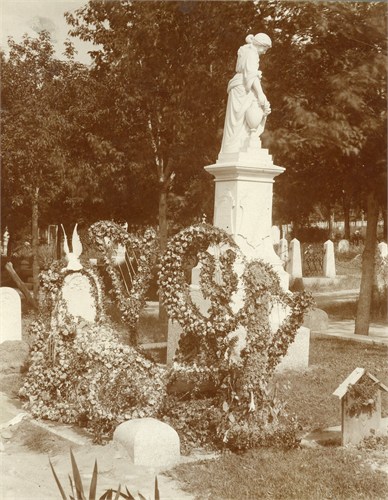Francis quickly rose to the position of mill manager. In 1864, Francis married Isabelle Siddoway (1849-1930), whom he had met when he worked with her father. Isabelle had traveled with her father and brothers to Salt Lake City in 1860 after the death of her mother. Isabelle met Francis when he lodged with the Siddoways. They raised a family of twelve children, although the first son died when he was three years old. By 1870, Francis was able to buy the Little Lumber mill. Through much hard work, the lumber mill became a great success. This success allowed Francis to invest in other businesses in Salt Lake City. As a result he became one of the wealthiest citizens of the city. At this time, Francis was called by the LDS Church to take a second wife, Sarah Carruth. They had six children together, but only two survived to adulthood. Sarah Carruth passed away thirteen years later in 1883. The two surviving children were raised by Isabelle. The wealth also enabled Francis to purchase a large plot of land at Seventh East and First South. On part of the land, he constructed the Armstrong Mansion, which still stands today. The rest of the land was set aside to give Francis and Isabelle's children places to build houses if they so wished. Besides business affairs, Francis was involved in politics. He served on the Salt Lake City School Board and City Common Council before he became mayor in 1886. During his tenure, he hid several LDS general authorities who were on the run from US Marshals for being polygamists. Francis also brought some unique touches to Salt Lake such as the electric trolley service and having one of the first houses to have indoor plumbing. By his death in 1899, Francis was on the board of directors for many companies, owned land in Utah and Idaho, and was one
of the most respected men in Utah.
Francis quickly rose to the position of mill manager. In 1864, Francis married Isabelle Siddoway (1849-1930), whom he had met when he worked with her father. Isabelle had traveled with her father and brothers to Salt Lake City in 1860 after the death of her mother. Isabelle met Francis when he lodged with the Siddoways. They raised a family of twelve children, although the first son died when he was three years old. By 1870, Francis was able to buy the Little Lumber mill. Through much hard work, the lumber mill became a great success. This success allowed Francis to invest in other businesses in Salt Lake City. As a result he became one of the wealthiest citizens of the city. At this time, Francis was called by the LDS Church to take a second wife, Sarah Carruth. They had six children together, but only two survived to adulthood. Sarah Carruth passed away thirteen years later in 1883. The two surviving children were raised by Isabelle. The wealth also enabled Francis to purchase a large plot of land at Seventh East and First South. On part of the land, he constructed the Armstrong Mansion, which still stands today. The rest of the land was set aside to give Francis and Isabelle's children places to build houses if they so wished. Besides business affairs, Francis was involved in politics. He served on the Salt Lake City School Board and City Common Council before he became mayor in 1886. During his tenure, he hid several LDS general authorities who were on the run from US Marshals for being polygamists. Francis also brought some unique touches to Salt Lake such as the electric trolley service and having one of the first houses to have indoor plumbing. By his death in 1899, Francis was on the board of directors for many companies, owned land in Utah and Idaho, and was one
of the most respected men in Utah.
Family Members
-
![]()
Elizabeth Siddoway Armstrong Bean
1865–1955
-
![]()
Francis Siddoway Armstrong
1867–1869
-
![]()
William Francis Armstrong
1870–1940
-
![]()
John Carruth Armstrong
1872–1874
-
![]()
Isabelle Armstrong Burton
1872–1961
-
![]()
Mary Hannah Armstrong Madsen
1875–1932
-
![]()
Annie Menetta Armstrong Livingston
1875–1954
-
![]()
Francis Marion Armstrong
1877–1878
-
![]()
George Carruth Armstrong
1878–1907
-
![]()
Emma Louise Armstrong Armstrong
1878–1957
-
![]()
Florence Grace Armstrong Bagley
1880–1933
-
![]()
Nellie Armstrong
1882–1882
-
![]()
Joseph Fielding Smith Armstrong
1883–1883
-
![]()
Sarah Ethel Armstrong Barton
1883–1963
-
![]()
Hazel Siddoway Armstrong
1885–1888
-
![]()
Irene Lenore Armstrong Brainard
1889–1975
-
![]()
Robert Lee Armstrong
1893–1966
Advertisement
Explore more
Sponsored by Ancestry
Advertisement





































